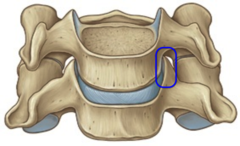Uncovertebral Joints
Description[edit | edit source]
Also known as Joints of Luschka, the uncovertbral joints are present from C3 to C7. They are rudimentary at birth and develop and evolve with age[1]. The lateral aspect of the vertebral bodies have superior projections know as the uncinate process. As the intervertbral discs become degenerative, these projections approximate with the body of the next highest vertebra resulting in degenerative joint changes and forming the uncovertbral joints.
Articulating Surfaces[edit | edit source]
Formed between uncinate processes below, and the uncus above.
Motions Available[edit | edit source]
They allow for flexion and extension and limit lateral flexion in the cervical spine.
Function[edit | edit source]
Thought to reinforce the intervertebral disc posterolaterally and therefore provide protection for structures at risk of disc herniation.
Prevents posterior linear translation movements of the vertebral bodies.
Important in providing stability and guiding the motion of the cervical spine[1].
Pathology[edit | edit source]
Osteophytes on the uncinate process resulting from uncovertebral arthrosis may compress both the spinal nerve root and the vertebral artery as they pass through the intervertebral and transverse foramina, respectively.
The articulations have also been found to precipitate torticollis when edematous and be acutely damaged in severe head and neck injuries[1]
Resources[edit | edit source]
Failed to load RSS feed from http://www.ncbi.nlm.nih.gov/entrez/eutils/erss.cgi?rss_guid=1HK5U4U_QH8OXf9bByAOk_hymRxOKEJevE1kyhu5mpKq7cbEe3: Error parsing XML for RSS
References[edit | edit source]
References will automatically be added here, see adding references tutorial.







